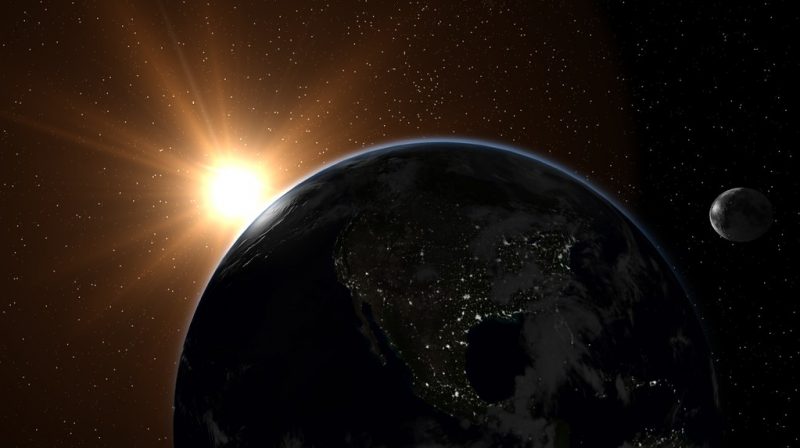
Year’s shortest season has begun
Did you know that Earth’s seasons are slightly different lengths? By season, we mean the time between a solstice and an equinox. The current season – between the December solstice and March equinox – is a touch shy of 89 days. It’s Earth’s shortest season.
The December solstice occurs when the sun reaches its southernmost point in our sky for this year. That’s what’s happening today, December 21, 2021, at 15:59 UTC. This solstice marks an unofficial beginning of the winter season in the Northern Hemisphere, and the start of the summer season in the Southern Hemisphere. Unofficial? Correct. While no government body has decreed it shall be so, we all generally agree that the solstices and equinoxes are hallmarks of seasonal change.
And, no matter where you are on Earth, the current season – between the December solstice and March equinox – marks the beginning of your shortest season.
Contrast the number of days in the present season with that of Earth’s longest season – the time between the June solstice and September equinox – in other words, a Northern Hemisphere summer or Southern Hemisphere winter. Earth’s longest season lasts 93.65 days.
But the current season is nearly five days shorter. Why?
Reason for the shortest season
The reason is that, every year in early January, the Earth swings closest to the sun for the year. This nearest point is called Earth’s perihelion. Because Earth reaches perihelion in late December and early January, our planet moves most swiftly in its orbit around now. That’s just physics: Planets move faster when they are closer to the sun than when they are farther from the sun. And it’s why a Northern Hemisphere winter, or Southern Hemisphere summer, is the shortest of the four seasons. It simply takes us fewer days at this time of year to move between a solstice and an equinox.
On the other hand, in early July, Earth is farthest from the sun and moving most slowly in its orbit. That’s why the longest season occurs at that time.
Here are the lengths of the astronomical seasons:
December solstice to March equinox: 88.99 days
March equinox to June solstice: 92.76 days
June solstice to September equinox: 93.65 days
September equinox to December solstice: 89.84 days
According to the computational wizard Jean Meeus, a Northern Hemisphere winter or Southern Hemisphere summer became the shortest season after the year 1246. The astronomical season between the December solstice and the March equinox will reach a minimum value of 88.71 days around the year 3500, and will continue to reign as the shortest season until about the year 6430.

Bottom line: Earth’s shortest season begins at the solstice on December 21, 2021. The coming season – Northern Hemisphere winter or Southern Hemisphere summer – is a touch shy of 89 days in length.
Read more: All you need to know about 2021’s December solstice
The post Year’s shortest season starts at the December solstice first appeared on EarthSky.
from EarthSky https://ift.tt/3esmZRb

Year’s shortest season has begun
Did you know that Earth’s seasons are slightly different lengths? By season, we mean the time between a solstice and an equinox. The current season – between the December solstice and March equinox – is a touch shy of 89 days. It’s Earth’s shortest season.
The December solstice occurs when the sun reaches its southernmost point in our sky for this year. That’s what’s happening today, December 21, 2021, at 15:59 UTC. This solstice marks an unofficial beginning of the winter season in the Northern Hemisphere, and the start of the summer season in the Southern Hemisphere. Unofficial? Correct. While no government body has decreed it shall be so, we all generally agree that the solstices and equinoxes are hallmarks of seasonal change.
And, no matter where you are on Earth, the current season – between the December solstice and March equinox – marks the beginning of your shortest season.
Contrast the number of days in the present season with that of Earth’s longest season – the time between the June solstice and September equinox – in other words, a Northern Hemisphere summer or Southern Hemisphere winter. Earth’s longest season lasts 93.65 days.
But the current season is nearly five days shorter. Why?
Reason for the shortest season
The reason is that, every year in early January, the Earth swings closest to the sun for the year. This nearest point is called Earth’s perihelion. Because Earth reaches perihelion in late December and early January, our planet moves most swiftly in its orbit around now. That’s just physics: Planets move faster when they are closer to the sun than when they are farther from the sun. And it’s why a Northern Hemisphere winter, or Southern Hemisphere summer, is the shortest of the four seasons. It simply takes us fewer days at this time of year to move between a solstice and an equinox.
On the other hand, in early July, Earth is farthest from the sun and moving most slowly in its orbit. That’s why the longest season occurs at that time.
Here are the lengths of the astronomical seasons:
December solstice to March equinox: 88.99 days
March equinox to June solstice: 92.76 days
June solstice to September equinox: 93.65 days
September equinox to December solstice: 89.84 days
According to the computational wizard Jean Meeus, a Northern Hemisphere winter or Southern Hemisphere summer became the shortest season after the year 1246. The astronomical season between the December solstice and the March equinox will reach a minimum value of 88.71 days around the year 3500, and will continue to reign as the shortest season until about the year 6430.

Bottom line: Earth’s shortest season begins at the solstice on December 21, 2021. The coming season – Northern Hemisphere winter or Southern Hemisphere summer – is a touch shy of 89 days in length.
Read more: All you need to know about 2021’s December solstice
The post Year’s shortest season starts at the December solstice first appeared on EarthSky.
from EarthSky https://ift.tt/3esmZRb

Aucun commentaire:
Enregistrer un commentaire